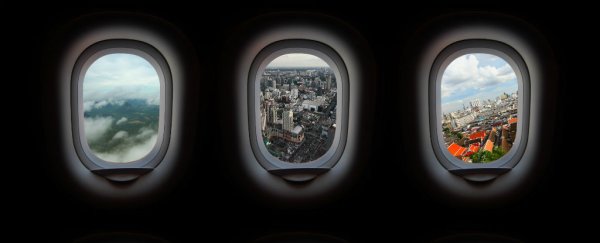One of the questions you might have been idly wondering as you sat through your most recent flight is why are aeroplane windows always round? Is it a design choice on the part of the airlines? Or is there some scientific reasoning behind it? The answer is actually pretty straightforward, as the video above from Real Engineering explains, but the engineering behind it is awesome.
First of all, they weren't always round - in the early days of aviation, planes had rectangular windows just like you have in your house. However, as planes became more advanced, they were made to fly higher for several reasons: to avoid turbulence in the lower atmosphere, to reduce drag, and to reduce fuel usage. As a result, cabins had to be pressurised to keep passengers comfortable in the rarefied atmosphere.
A pressurised cabin requires a cylindrical shape in order to work properly, and that in turn creates a pressure difference between the inside air and outside air that increases as the plane gets higher. The plane body expands ever so slightly, and thus stress and strain is applied to the material - and this is where the shape of the windows becomes an important part of the equation.
On a perfectly rounded cylinder, the stress flows smoothly through the material, a flow that's interrupted by the introduction of a window. If that window is rectangular, the interruption in stress flow is more significant, and pressure builds up on the sharp corners - pressure that can eventually smash the glass and crack the plane body. If the window is oval, the stress levels are more evenly balanced out.
Unfortunately, it took two airliner crashes and "one of the most remarkable pieces of scientific work ever done" before engineers realised the problems that square windows were causing, as the BBC reports. All future aircraft were designed with rounded windows to protect the integrity of the fuselage, and they've stayed that way ever since.
The same principle applies to cargo and cabin doors, and of course circular windows are also in evidence on ships and spacecraft because of their greater structural integrity.
You might also be wondering about the 'breather hole' that appears in all aeroplane windows. Again, it's to do with managing the pressure and the tension that builds up between the internal and external pressure. As Robbie Gonzales at io9 explains, each window is actually made up of three layers, and the hole allows the air pressure between the outer and middle panes to equilibrate. As a result, cabin pressure is only applied to the outer pane, with the middle pane preserved for emergencies.
So there you have it - and if you're stuck for small talk the next time you're sat next to a stranger on a flight, you can wow them with some informed engineering knowledge.
